Fortunately, this week I was down in Sacramento and stumbled upon a little Indian market, where I found actual moong dal, along with some chana dal and a bunch of the spices I was trying to get in a hurry last week (for my Bangladesh entry) but couldn't find anywhere. So I stocked up, and with authentic ingredients on hand was able to pretty easily pick this week's recipes, which are from nearby Balochistan.
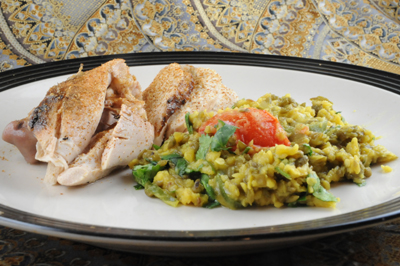 |
| Chicken Sajji Masala and Moong Dal. |
First an explanation: Balochistan is not a country. This time I'm quite sure of it. Balochistan is first and foremost the largest of four provinces in Pakistan, comprising about 44% of the nation's total land mass. Regionally and ethnically speaking, it also extends past the borders of Pakistan into Iran and southwestern Afghanistan. Geographically speaking, Balochistan is in the Iranian plateau. It gets its name from the Baloch tribes, who first populated the area around 1000 AD. Most of the Balochi population is concentrated in Pakistan, with roughly 6.6 million of them making their homes there.
Compared to the rest of Pakistan, Iran and Afghanistan, the traditional cuisine of Balochistan has pretty significant regional differences, which is why I decided to give it its own entry. Traditional Balochi food tends to be aromatic rather than spicy, and a lot of it is cooked over an open flame or hot coals.
Which brings me to my first recipe of the week: Chicken Sajji Masala (from Khana Pakana). Here are the ingredients:
For the chicken:
- 1 whole chicken
- 1 cup white vinegar
- 1 tsp red chili powder
- 1 tsp black pepper
- 1/2 tsp salt
- 2 tsp garlic paste
- Juice of 1/2 lemon
For the spices:
- 1 to 1 3/4 oz whole red chilies
- 1/2 tsp salt
- 1 tsp carom seeds
- 2 tsp fennel seeds
- 2 tsp cumin seeds
- 2 tbsp coriander seeds
- Lemon juice for sprinkling
Ingredient note: carom seeds are also called "ajwain," and they can be purchased at most Indian grocers or from various online sources (I got mine on Amazon.com). When they arrive, don't be alarmed if you see the subtitle "celery;" like Indian bay, Indian celery is not the same as its American counterpart.
I found a couple of Balochi dal recipes that sounded pretty good, but the one I settled on was a moong dal since it was the simplest of the two, and since I was making this on a Sunday I didn't want to spend half my weekend in the kitchen. Here are the ingredients for the moong dal (from Khana Pakana):
- 1 cup moong dal
- 3 cups water
- 1/2 tsp turmeric powder
- salt to taste
- Juice of 1/2 lemon
- 2 to 3 green chiles, sliced
- 1/2 tbsp ghee
- 1/2 tsp cumin
- 2 to 3 whole cloves
- 1/2 inch cinnamon stick
- 3 to 4 cloves garlic, finely diced
- 1 tsp grated ginger
- 1 small tomato, quartered
- 1 tbsp cilantro
And then for the second week in a row, I chose a dessert recipe based on the name: Chocolate Burfi, otherwise known as "Chocolate Barfi." Doesn't that sound yummy? Haha. (This recipe is also from from Khana Pakana.)
Ingredients:
- 1 cup maida or pastry flour
- 2 cups sugar
- 1 cup ghee
- 1 cup milk
- 1/4 cup milk powder
- 2 tbsp cocoa powder
- 1/2 cup finely chopped cashews
Starting with the sajji masala: first of all it is important to take note of the fact that the chicken needs to marinate overnight, which of course I did not take note of because I'm really bad about reading over recipes before I actually start making them. So mine only marinaded for a couple of hours, but it did taste pretty good so I guess my shortcut wasn't too harmful.
To make the marinade, just mix the vinegar, chili powder, black pepper, salt and garlic paste together in a large bowl. Add the whole chicken and turn to coat. Refrigerate overnight, turning occasionally to make sure you get good coverage.
While the chicken is marinading, put the spice ingredients together in a hot pan. Keep stirring, because you aren't using any oil and the spices will burn pretty quickly if left unattended. When they become fragrant, remove them from the heat and transfer them to whatever spice-crushing appliance you own. Crush them into a fine powder. If you have larger bits in your mix, it's a good idea to sift the spices through a fine mesh strainer as the bits won't be very pleasant to bite into. Warning: don't be tempted to inhale your spice mixture, because it really hurts when it gets in your nose. Set the mixture aside.
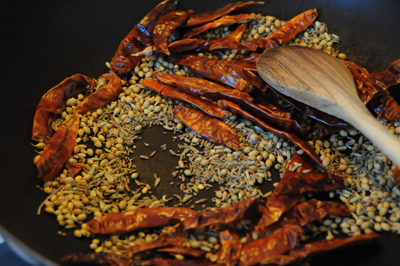 |
| The spice mixture for this recipe is heated in a dry pan. |
When the chicken has finished marinading, transfer it to a preheated oven and cook at 350 degrees for about 30 to 45 minutes. Meanwhile, light some coals in your barbecue (propane won't really work for this recipe, you need the smoking coals to achieve the right flavor). When they are hot, transfer the whole chicken to your barbecue and close the lid.
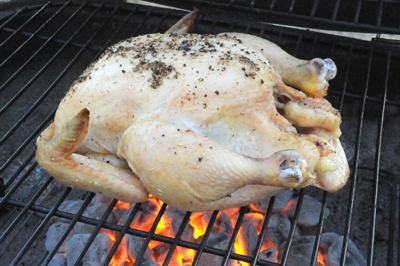 |
| After 30 to 45 minutes in an oven, the chicken goes on the barbecue over hot coals. |
Traditionally, you would put the chicken on a spit for this step, but I'm not set up for that. Just putting it on the grill seemed to work fine, though.
When the chicken develops a dark, crispy skin take it off the grill and check the temperature in both thighs (barbecues can cook unevenly). It should read about 175. If it doesn't, transfer back to your oven and keep cooking until the right temperature is achieved.
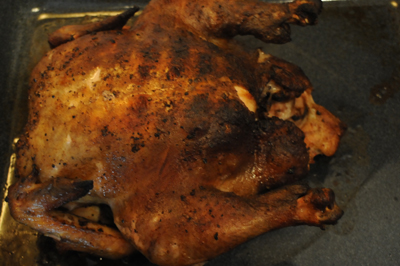 |
| Here's the chicken after about 15 minutes on the grill. |
Like all roasted meat, you should let your chicken rest for about 10 or 15 minutes before carving. This will allow the juices to remain in the meat rather than draining out onto the cutting board.
Sprinkle each serving with some lemon juice and a little bit of the prepared spice mixture.
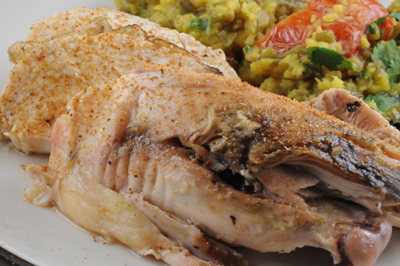 |
| Chicken Sajji Masala withe a little bit of spice mixture sprinkled on top. Yum! |
Now on to the moong dal. This recipe requires a little bit of preparation, but is actually pretty simple.
First soak the moong dal in cold water for about 20 minutes. Drain, then add to a pot with the water, turmeric and salt. Make sure to skim off the foam that forms as the water boils.
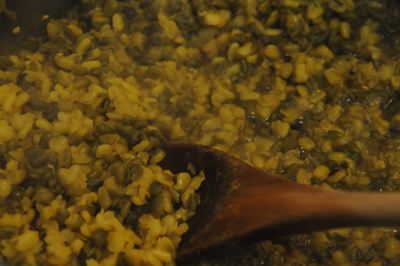 |
| The moong dal needs to be soaked for about 20 minutes before cooking. |
Keep simmering until the moong dal is soft, adding about a half cup water at a time as necessary. The dal is finished when you can successfully moosh it up a little on the side of the pan. It should be thick without any visible pools of liquid. Now add the lemon juice and the sliced green chiles.
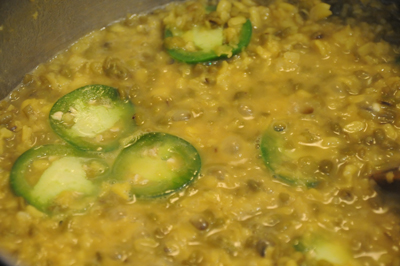 |
| Add the sliced chili peppers (I just used jalapenos). |
While the dal is cooking, heat the ghee and cook the cumin seeds, cloves, cinnamon, garlic and ginger. Keep stirring until fragrant. Add the quartered tomatoes and saute for one or two minutes, then pour the contents of the pan over the dal. Cover the pot for five minutes or so before serving. Garnish with the chopped cilantro.
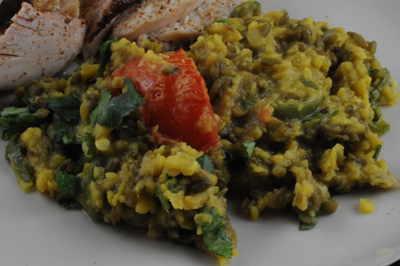 |
| The tomato was a nice touch. |
Now for the weird part of the meal: the chocolate burfi. You should have seen the look on Hailey's face when I told her this was what we were going to make for dessert. Of course she soon got over the strange linguistic juxtaposition between the word "burp" and the word "barf" based on the presence of the word "chocolate," so after a few seconds of confusion it was on with the show. Here's how it's done:
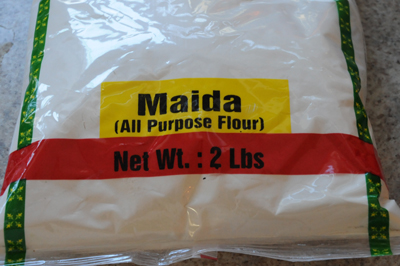 |
| This maida is labeled "all purpose," but it is really more like a pastry flour. |
Add all the ingredients except the cashews to a hot pan. Now stand there and kiss 20 minutes of your life goodbye as you stir, stir and stir, followed of course by more stirring. Keep going until the mixture starts to pull away from the sides of the pan.
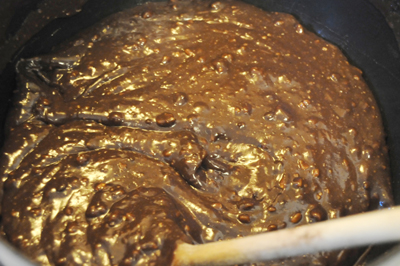 |
| Keep stirring the burfi (I know, this is a terrible photo). |
Now drop in the cashews and keep stirring. By now the mixture should be just barely thin enough to pour, but thick enough so that your arm muscles are screaming at you "enough with the stirring, already." Pour the mixture into a greased pan and cut into squares (you may have to reinforce your cuts later as the burfi cools).
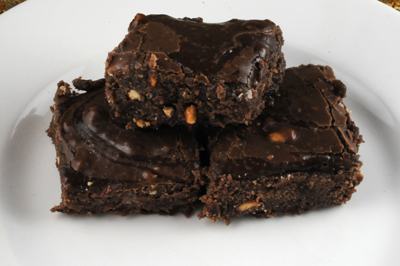 |
| Chocolate burfi. It tasted weird. |
The family verdict: We all ate and enjoyed this meal (well, pretty much). I have to say this chicken for all its strange origins was probably the single most juiciest chicken I've ever made. If it wasn't such a pain to light the charcoal grill I might always cook chicken this way. The crispy skin kept the juices in and the coals gave it a nice smoky flavor that went really well with the spice mixture and lemon juice.
My moong dal came out a little salty, but hidden in there were some really wonderful flavors. Martin and I both liked the addition of the tomatoes. My kids of course greatly feared the moong dal and I'm pretty sure none of them tried it, though Hailey insisted that she did (I saw no actual evidence of this happening of course).
The chocolate burfi was mildly disappointing. The texture was really chewy, almost difficult-to-chew, and having never eaten burfi before I have no idea if it was supposed to come out that way. It also tasted really strongly of ghee, which I'm sure is not unpleasant to most people living in the region but didn't sit quite right on my American tastebuds (though I don't usually have a problem with ghee when used in a savory setting). If you aren't a real stickler for authenticity, you might want to try this recipe with butter instead of ghee.
Now it's back to the Caribbean, and no, I'm not going to comment.
Next week: Barbados
For printable versions of this week's recipes:












0 comments:
Post a Comment